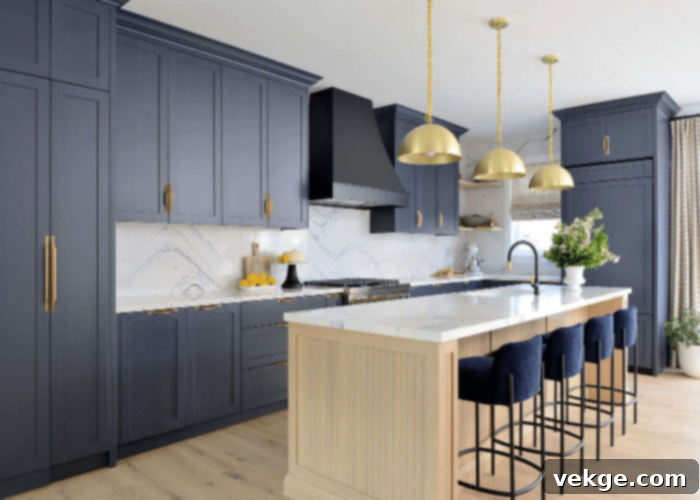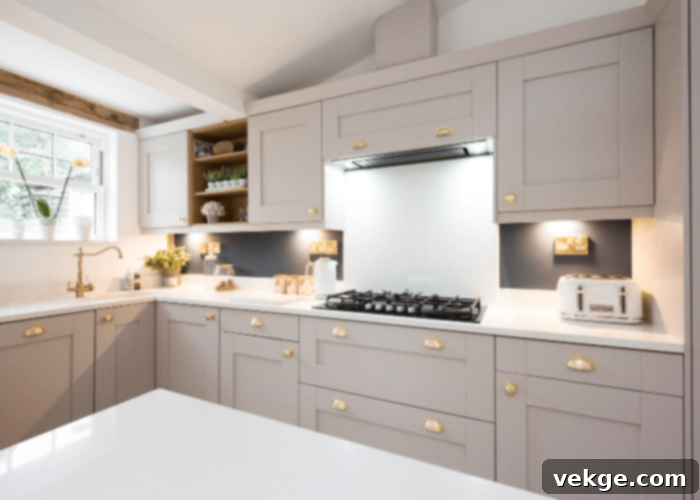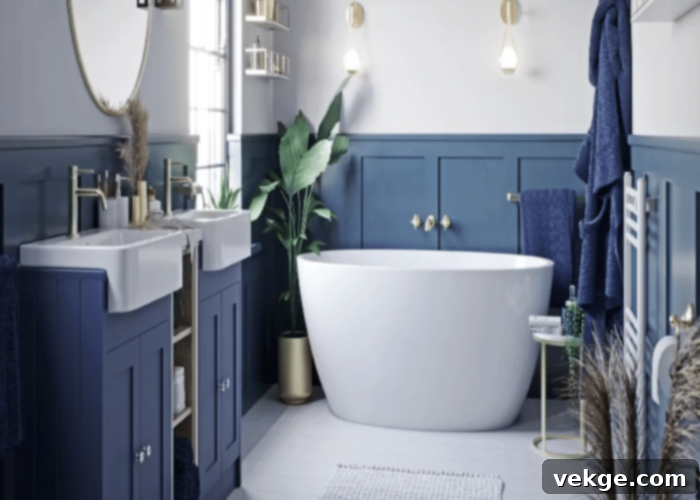Unlocking Durability: Can Cabinet Paint Truly Resist Heat and Humidity?
Imagine stepping into a kitchen or bathroom where every detail exudes perfection: sleek countertops, the comforting warmth of a steamy shower, and beautifully chosen cabinets that perfectly complement your personal style. Yet, a crucial question often arises for homeowners: “Can cabinet paint really withstand the relentless assault of heat and humidity?” This concern is especially valid in areas like kitchens, where cooking steam and spills are commonplace, and bathrooms, which are routinely subjected to high moisture levels. Finding the right paint that offers robust protection for your cabinets is not just about aesthetics; it’s about long-term preservation and peace of mind.
In this comprehensive guide, we will delve into the science and strategic approaches behind selecting and applying cabinet paints. Our aim is to help you understand that choosing the right cabinet paint is far more than simply picking a color. It’s an investment in endurance, resilience, and a finish designed to conquer challenging environmental conditions. We invite you to explore the fascinating blend of chemistry, aesthetics, and durability that makes modern cabinet paints truly remarkable.
The Science of Resilience: How Cabinet Paint Resists Heat and Humidity
The answer is a resounding yes: high-quality cabinet paints are specifically engineered to resist both heat and humidity. Unlike standard wall paints, cabinet paints feature a more robust formulation, incorporating thicker pigments and specialized resins that allow them to withstand significant wear and tear, temperature fluctuations, and moisture exposure. This enhanced durability is absolutely essential because cabinets in kitchens and bathrooms are constantly exposed to environmental stressors. From the steam generated by hot showers and boiling pots to the splashes from sinks and the ambient humidity, these areas demand a paint that offers superior protection. The secret lies in their advanced composition, typically featuring acrylic resins, mildewcides, low-VOC formulas, and UV stabilizers, all working in concert to create a formidable moisture-resistant barrier.
Let’s take a closer look at how these critical ingredients contribute to developing cabinet paint that not only withstands but thrives in the face of heat and humidity.

1. The Power of Acrylic Resins
Acrylic resin is a synthetic polymer renowned for its exceptional durability and inherent water-resistance. When applied, it forms a strong, flexible, and non-porous film on the cabinet surface. This film acts as a crucial barrier, preventing heat and moisture from penetrating the wood beneath and causing unsightly damage such as cracking, peeling, or warping of the paint layer. The flexibility of acrylic resins is key; it allows the paint film to expand and contract subtly with changes in temperature and humidity without compromising its integrity. This resilience is vital in dynamic environments like kitchens. Furthermore, the robust polymer chains within acrylic formulations make the paint largely insoluble in water once cured, offering superior protection against splashes and moisture. These resins also contribute to the paint’s resistance against UV rays, which can otherwise degrade the paint over time.
2. The Essential Role of Mildewcides
In environments rich in moisture, wood surfaces are highly susceptible to the growth of mold and mildew. These microscopic organisms not only create unsightly stains and unpleasant odors but also cause significant structural damage to cabinets, leading to discoloration, softening of wood, and eventual decay. Mildewcides, integrated into cabinet paint formulations, are active antimicrobial agents designed to prevent this issue. They work by inhibiting the growth of mold and mildew spores before they can take root and proliferate on the cabinet surface. By disrupting the metabolism of these microorganisms, mildewcides ensure that your cabinets remain clean, healthy, and structurally sound, effectively preventing moisture-related biological degradation and contributing to a healthier indoor environment.
3. The Advantage of Low-VOC Formulas
Traditionally, paints dried quickly due to the rapid evaporation of volatile organic compounds (VOCs), which could lead to a less flexible film prone to cracking and peeling. Modern cabinet paints often feature a low-VOC (volatile organic compounds) formula that utilizes advanced resins and co-solvents to slow down the drying process. This extended “open time” allows the paint to level more effectively, resulting in a smoother, more uniform finish with fewer brush marks. Crucially, low-VOC paints typically have a higher solid content, meaning more pigment and binder and less solvent, which creates a thicker, more durable film that acts as a superior barrier against moisture. Beyond their enhanced durability and aesthetic benefits, low-VOC paints are also environmentally friendlier and significantly reduce the emission of harmful fumes, making them safer and more pleasant to apply and live with. Their opaque nature also means they offer better coverage and resistance to light and moisture penetration.
4. Protecting with UV Stabilizers
While often associated with outdoor products, UV stabilizers play an important role in indoor cabinet paints, especially for cabinets exposed to direct or indirect sunlight through windows. Ultraviolet (UV) rays can degrade the chemical bonds within paint molecules, leading to cracking, peeling, fading, and discoloration over time. UV stabilizers in cabinet paint formulations work by absorbing these harmful UV rays, effectively neutralizing their damaging effects. They form a protective layer that shields the paint’s pigments and binders, extending the lifespan of the paint finish and ensuring that your cabinet colors remain vibrant and true for years. While UV stabilizers are crucial for color retention and preventing molecular breakdown, it is important to remember that their primary function is not to act as a direct barrier against moisture, but rather to protect the paint from light-induced degradation.
How to Choose the Right Cabinet Paint that Resists Heat and Humidity
Selecting the ideal paint for your cabinets involves more than just picking a shade; it requires careful consideration of its composition and performance capabilities, particularly in challenging environments. Here’s how to make an informed decision:

1. Choose Paint Specifically Designed for Cabinets
It’s crucial to understand that not all paints are created equal. While general wall paints are formulated for broad coverage and ease of application, cabinet paints are engineered for superior hardness, scrubbability, and resistance to impacts, chemicals, and, most importantly, moisture. When selecting paint, always look for products explicitly labeled “cabinet paint” or “trim and door paint.” These formulations contain a higher concentration of durable resins, such as acrylic or urethane-modified acrylics, which provide the robust protective film necessary to withstand the daily rigors of kitchen and bathroom environments. Verify the label for mentions of acrylic resins, which are key indicators of moisture and heat resistance.
2. Opt for Water-Based Paints (Acrylic-Urethane Hybrids)
Water-based paints, particularly advanced acrylic-urethane hybrids, offer significant advantages over traditional oil-based paints for cabinets. They are less volatile, meaning fewer harsh fumes and easier cleanup with just soap and water. Modern water-based formulations dry to a tough, flexible film that is highly resistant to cracking and peeling, even when subjected to thermal expansion and contraction or high humidity levels. Unlike oil-based paints, they do not yellow over time, especially in areas exposed to light, maintaining their true color longer. Many quality water-based cabinet paints also incorporate UV stabilizers, further protecting against color fade and degradation. These paints provide excellent adhesion and a smooth, hard finish that stands up well to cleaning and everyday use.
3. Ensure the Paint Contains Mildewcides
As previously discussed, mildewcides are indispensable in preventing mold and mildew growth, which can severely damage cabinets and pose health risks. When browsing paint options, always review the manufacturer’s product data sheet or label. Look for explicit mention of mildewcides or antimicrobial agents in the paint’s formulation. This ensures an added layer of protection against biological growth, which is particularly prevalent in warm, humid environments like those surrounding sinks, stoves, and showers. Choosing a paint with mildewcides extends the life of your cabinets and contributes to a healthier living space.
4. Select the Correct Finish
The paint finish significantly impacts not only the aesthetic appeal but also the durability and ease of maintenance of your cabinets. Cabinet paints are available in various sheens: matte, satin, semi-gloss, and gloss. Each has distinct characteristics:
- Matte/Flat: Offers a soft, non-reflective look, but is generally the least durable and most difficult to clean, making it less ideal for high-traffic, high-humidity areas.
- Satin: Provides a subtle sheen, making it more durable and easier to wipe clean than matte. It’s a popular choice for a balanced look and reasonable durability.
- Semi-Gloss: A common and highly recommended choice for cabinets. It offers a noticeable sheen, excellent durability, and is very easy to clean. Its smoother surface helps repel moisture.
- Gloss: Delivers the highest shine and is the most durable and easiest to clean. While very practical for protection, its high reflectivity can sometimes highlight surface imperfections.
For kitchens and bathrooms, semi-gloss and satin finishes are often preferred due to their balance of durability, cleanability, and aesthetic appeal. Gloss finishes offer maximum protection and are excellent for heavy-use areas, though some might find them too reflective.
5. Prioritize Cabinet Paint with Strong Adhesion Strength
Excellent adhesion is the foundation of a long-lasting paint job. Paint with superior adhesion strength forms a strong bond with the cabinet surface, preventing common issues like chipping, cracking, and peeling, thereby enhancing overall durability. The quality of binders, solvents, and pigments within the paint formulation all contribute to its adhesive properties. Look for paints that specify high-quality resins known for their adhesive capabilities. Additionally, proper surface preparation, including thorough cleaning and priming (especially with an appropriate bonding primer), plays a critical role in maximizing the paint’s adhesion to the substrate. Choosing paints with robust organic pigments and water-based solvents often indicates a high-performance formulation designed for durability and strong adhesion.
Expert Tips to Paint Your Cabinets for Maximum Durability
Achieving a professional and long-lasting finish on your cabinets requires more than just good paint; it demands careful preparation and application. Follow these expert tips to ensure your cabinets are not only beautiful but also built to withstand the elements:

- Choose Paint That Is Easy to Apply and Clean Up: Opt for high-quality water-based or hybrid enamel paints specifically formulated for cabinets. These tend to have a longer open time, allowing for a smoother application, and they clean up easily with water, minimizing exposure to harsh chemicals.
- Clean the Cabinets Thoroughly Before Applying Paint: This is perhaps the most critical step. Grease, grime, and old food residue will prevent paint from adhering properly. Use a strong degreaser (like TSP substitute) to meticulously clean all surfaces. Rinse thoroughly and allow to dry completely.
- Choose a Color That Best Suits the Décor and Interior: While not directly related to durability, selecting the right color ensures your hard work yields a result you’ll love. Consider the room’s lighting, existing colors, and your personal style. Lighter colors can make small spaces feel larger and brighter, while darker tones add drama.
- Apply a High-Quality Primer Before Painting: A good primer creates a uniform, adhesive surface for your topcoat. It helps block stains, promotes better adhesion, and ensures a smoother, more even final color. For previously stained or glossy cabinets, a bonding primer or shellac-based primer is highly recommended.
- To Make the Paint Durable, Apply Multiple Thin Coats: Instead of one thick coat, which can sag, drip, and take ages to dry, apply two to three thin, even coats. Thin coats cure harder and are less prone to scratching and chipping. This layered approach builds resilience.
- Let the Paint Dry Completely Between Coats: Patience is paramount. Always follow the manufacturer’s recommended drying times between coats. Rushing this step can lead to an uneven finish, poor adhesion between layers, and a less durable overall result. Lightly sanding with fine-grit sandpaper (220-320 grit) between coats and wiping with a tack cloth can also improve adhesion and smoothness.
- Ensure Adequate Ventilation: While painting, especially with any type of paint, ensure good air circulation. Open windows and use fans to help with drying and to dissipate any lingering fumes.
- Use Quality Painting Tools: Invest in good brushes (like angled sash brushes for details) and foam or microfiber rollers for smooth, lint-free finishes. Quality tools lead to quality results.
- Inspect the Cabinets Regularly for Signs of Damage, Fading, and Discoloration: Post-application, periodic inspections allow you to catch small issues early. Address minor chips or wear spots promptly to prevent moisture ingress and larger problems down the line.
Conclusion
As we’ve delved into the sophisticated world of cabinet coatings, finishes, and formulations, we have uncovered the undeniable secret: modern cabinet paints are indeed meticulously engineered to resist the challenges of heat and humidity. The foundation of their performance lies in high-quality acrylic resins, which provide flexibility and an impervious barrier. Mildewcides stand guard against microbial growth, protecting the wood from degradation, while low-VOC formulas contribute to a durable, flexible, and environmentally conscious finish. Though not a direct moisture barrier, UV stabilizers play a vital role in preserving the aesthetic integrity and longevity of the paint by preventing sun-induced damage.
These specialized paints are far more than just multiple layers of color; they are robust guardians of both aesthetics and functionality. Whether you are painting brand-new cabinets or embarking on an exciting upgrade of your existing ones, the insights from this guide should empower you to select the ideal cabinet paint. By making an informed choice, you can ensure your cabinets not only look stunning but also stand tall and resilient against the constant assault of heat and humidity for many years to come.
Embrace the power of innovation in paint technology, and let your beautifully finished cabinets make a lasting statement of style and durability in your home.
